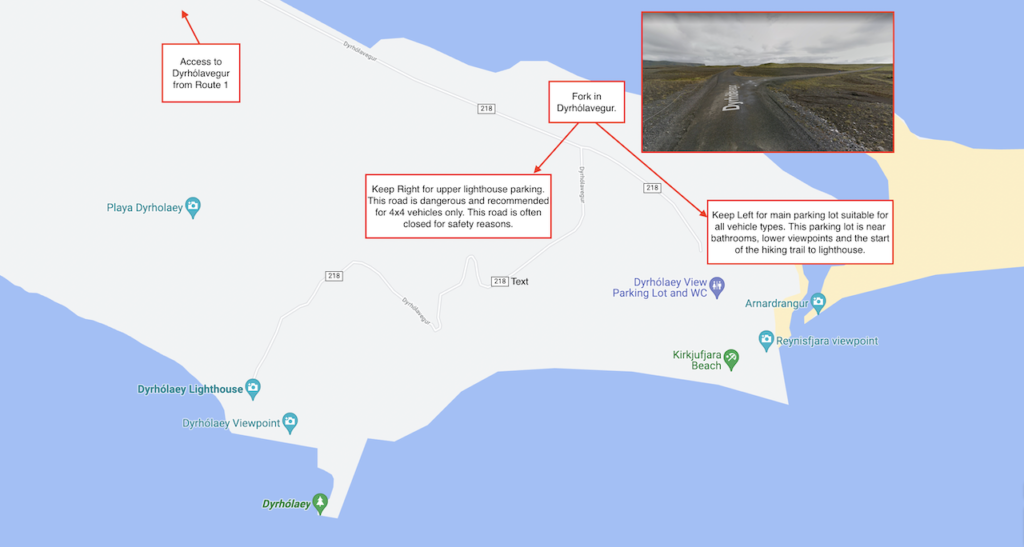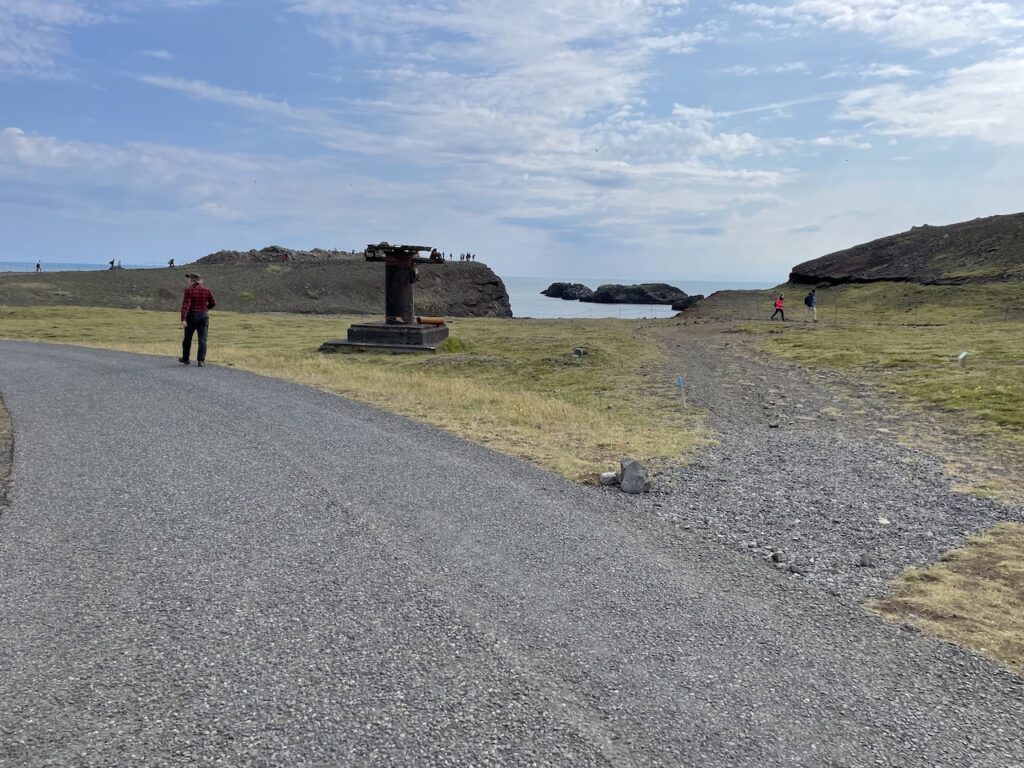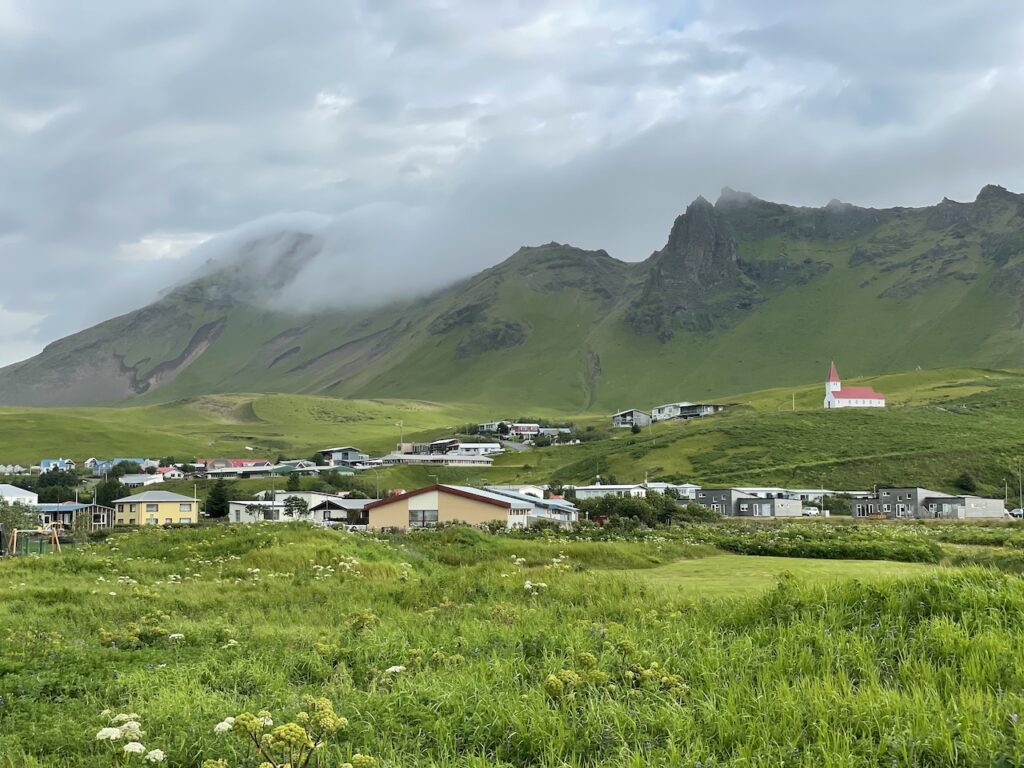Dyrhólaey is a protected nature reserve on Iceland’s southern coast. It’s home to the namesake pomotory, famous for the arch hole naturally cut through it, and the darling lighthouse that sits just above it. The reserve is best known for its views, which include miles of black sand coastline, multiple glaciers, and even a resident puffin colony in the summer. If this beautiful spot is on your Iceland bucket list, this guide will help you plan the perfect visit.
In This Guide
Here’s what we’re covering in this guide. We invite you to read the full post or jump ahead to the section you’re most interested in.
- What is Dyrhólaey
- Things to See at Dyrhólaey
- How to Get to Dyrhólaey
- Hike to Dyrhólaey Lighthouse
- Amenities at Dyrhólaey
- Tips for Visiting Dyrhólaey
- Where to Stay Near Dyrhólaey

What is Dyrhólaey
Dyrhólaey is a nature reserve located on the southern coast of Iceland. The term Dyrhólaey is often thrown around in reference to different things in the area, so let’s clarify terms first.
- Dyrhólaey: The name Dyrhólaey technically refers to the volcanic rock peninsula with a hole in it. It’s a nearly 400-foot high promontory with a naturally formed hole that juts the furthest into the sea.
- Dyrhólaey Lighthouse: The lighthouse sits just above the promontory and is named after Dyrhólaey. It’s the second highest lighthouse in Iceland (by focal plane) and allegedly the brightest.
- Dyrhólaey Nature Reserve: The entire area around the promontory, including the upper and lower viewing areas, is Dyrhólaey Nature Reserve. It’s often simply referred to as Dyrhólaey as well.

The Dyrhólaey promontory is the second southernmost point of mainland Iceland (excluding the Westman Islands). It used to be the southernmost point until 1918 when the Katla volcano erupted. The eruption created the land mass of Kötlutangi which is now the southernmost point.
Dyrhólaey Nature Reserve is split into two sections, Háey (“the high island”) and Lágey (“the low island”) that each offer different views and experiences.
From the higher area, you will get the best views of Dyrhólaey’s rock arch, an up close look at the lighthouse and epic views of the coast. The lower area provides a stunning up-close look at the basalt columns that make up this part of the cape and an amazing view of Reynisfjara black sand beach. You can find puffins in both areas!

Things to see at Dyrhólaey Nature Reserve
At Dyrhólaey Nature Reserve, it’s not just about what you can see at the reserve but what you can see from it. The views and lookouts at Dyrhólaey are some of the best in Iceland. Let’s explore the different areas and viewpoints at Dyrhólaey and things to look for.
Dyrhólaey Arch
The pomotory of Dyrhólaey, or the cliff with the hole in it, is of course a highlight. The name Dyrhólaey roughly translates to “door hill island” in reference to the door-shared opening that cuts through a hill.

The pomotory is nearly 400 feet high and 325 feet long. The hole that cuts through it is about 175 feet wide and 65 feet high. During low seas, boats can sail through the hole and in 1993, a small plane actually flew through it several times!
Today, you cannot walk out onto the pomotory for both safety and natural preservation reasons, but you can view it from the two different view points listed next.
Reynisfjara Viewpoint (AKA lower viewing area or Lágey)
To get to the Reynisfjara Viewpoint from the main (lower) parking lot, follow the gravel pathway past the bathrooms in the direction of the water. In about a hundred feet you’ll reach the first viewing area.
A large volcanic rock, Arnardrangur, pokes out from the sand and feels almost otherworldly. During low tide, you can actually walk on the black sand in this area and view the basalt columns up close. Be extremely careful if you do so, and do not go near or into the water.

The gravel pathway continues up a small hill. From the top and looking west, you’ll be treated to a wide view of the Dyrhólaey arch and to the east an even better view of Reynisfjara black sand beach. If you look north (opposite the water), you can even see Sólheimajökull glacier on a clear day. You may also see puffins on the cliffside in this area during the summer.

Dyrhólaey Viewpoint
The best views of Dyrhólaey are from Dyrhólaey Viewpoint. This is the closest view and most direct angle from which to see the rock arch. It’s the best view of the arch, but keep going because the best views of the full coast are a bit further.
The Dyrhólaey Viewpoint is located about halfway between the promontory and the Lighthouse. Getting here is a bit more work than getting to the Reynisfjara Viewpoint. It’s a pretty steep hike up from the lower viewing areas, but it is definitely worth it if you’re physically able to make the hike. (I’ll go through the hiking instructions shortly.)

Dyrhólaey Lighthouse
Situated at the highest point of Dyrhólaey Nature Reserve is the Dyrhólaey Lighthouse. It’s a beautiful but simple structure that resembles a tiny castle. (Personally, it really reminded me a lot of the castle in Bratislava.)

It’s one of the tallest lighthouses in Iceland, with a focal plane of 404 feet (this is the distance from the light to the water). It’s allegedly the brightest lighthouse in Iceland, and the light from the lighthouse can be seen at sea from as far as 30 miles away. (I can’t officially confirm this, but I have seen it stated in a few unofficial places.)
The lighthouse is beautiful, but even more beautiful is the view from near it. To the east and west, you can see miles of coastline and black sand beaches. To the north, you’ll see glaciers and mountains and to the south a seemingly endless expanse of ocean. Below on the cliffs, you may even spot Atlantic puffins in the summer.

Puffins
There are millions of Atlantic puffins in Iceland, and many of them call Dyrhólaey Nature Reserve home during mating season. The cliffs at Dyrhólaey are considered to be one of the best places to spot wild puffins in all of Iceland.

During the summer months (June – August), you can spot puffins on the cliffs from the marked walkways at the reserve. The best spots to view puffins at Dyrhólaey are on the cliffs near the lower Reynisfjara Viewpoint and just past the Dyrhólaey Lighthouse. In July, we spotted many puffins in both places.
Puffins spend most of their time out at sea and only come to shore for mating and nesting. This is why you’ll only see puffins at Dyrhólaey in the summer months (May – August). To protect the birds during this time, the nature reserve actually closes during the evening hours during mating season. Days and times may change and vary by actual nesting activity each year.

To the best of my knowledge, Dyrhólaey Nature Reserve is typically closed to the public in the evenings (7 PM – 9 AM) from late May through late June. The marked pathways typically remain open during the day (9 AM – 7 PM), but may close completely for a few weeks in early May.
There is no official website with hours posted, so we recommend checking with a visitor center in Iceland. You might also find updates on TripAdvisor or a concierge at your hotel prior to your arrival.
If you want to see puffins at Dyrhólaey without risk of closure, plan to visit in mid to late summer (July – August).
How to Get to Dyrhólaey Nature Reserve
Dyrhólaey Nature Reserve is located off Route 1 on Iceland’s southern coast just about 100 miles from Reykjavik. If you’re coming from Reykjavik, about 25 miles after the small town of Holt you will take a right onto Dyrhólavegur. Continue straight on this road until you reach a fork in the road.

To reach the main parking lot, continue straight (left) at the fork. This parking lot is the largest and easiest to get to. It’s near the bathrooms and offers easy access to the lower viewing area near Reynisfjara Viewpoint and the start of the hiking trail to Dyrhólaey Lighthouse.
To reach the upper parking lot near Dyrhólaey Lighthouse, take a right at the fork. This road is known for being quite treacherous and is only recommended for 4×4 vehicles as it’s very steep and the switchbacks are quite sharp and narrow. This road is often closed for safety reasons, and it was closed during our visit in July 2021.
If you enter “Dyrhólaey Lighthouse” or even just “Dyrhólaey” into Google Maps, the route suggested will typically be the more dangerous road, without any warning about the terrain or possible closure. We suggest you enter “Dyrhólaey View Parking Lot” into Google Maps, which will lead you straight to the lower parking lot on the safest road.
Hike to Dyrhólaey Lighthouse
The only way to get from the main lower parking lot and lower viewpoints up to the lighthouse and higher viewpoints is to hike. It is about 1 km in each direction, with an elevation change of about 100 meters. The hike is considered moderately difficult.

The trail starts near an iron statue just off the main path, past the bathrooms and before the lower viewpoints. It begins as a mostly flat gravel pathway. At about 3/4 of the distance, it becomes quite steep. At points, it is very rocky with many stone steps leading upward.
The hike took us 22 minutes from start to finish. We are two pretty fit adults and fast walkers, though my husband was wearing our one-year old in a baby carrier. We were definitely winded by the end, but we didn’t need to take breaks along the way and at no point felt unsafe.

From the top, you’re treated to sweeping views of Dyrhólaey arch, black sand beaches for miles, multiple glaciers, and of course, you get to the see the lighthouse up close. Just past the lighthouse is a cliff, which is an amazing spot to watch for puffins.
At several points on our way down, people asked “Is it worth it?!” The answer we gave then and stand by today is, “Yes, if you can can safely keep going, do it. It’s stunning.”

Amenties at Dyrhólaey Nature Reserve
Dyrhólaey Nature Reserve is a relatively small area with limited amenities, but there are a few to note.
- Parking: Free parking is available near the lower viewpoints and by the lighthouse for 4×4 vehicles when the road is open.
- Bathrooms: Yes, but they cost 200 ISK ($1.50 USD). The machine at the entrance takes credit cards.
- Wifi: No
- Food & Drink: No
- Souvenirs: No

Tips for Visiting Dyrhólaey
- Check for closures in advance. The reserve is typically open 24 hours, but in May & June it’s often closed from 7 PM – 9 AM. Be sure to confirm the hours before you arrive. There is no official website so we suggest checking TripAdvisor, a tourist center or even asking at your hotel or guesthouse.
- Plan for 90 minutes. We suggest spending about 1.5 – 2 hours at Dyrhólaey, which includes a hike to the lighthouse and back.
- Exercise caution. Stay on the marked paths and do not approach the cliffside. Rocks may be unstable and it’s a very long fall to the ocean below. In lower viewing areas, stay clear of the water. This area is known for unpredictable and dangerous currents.
- Be respectful of the Puffins. Do not approach the puffins or their nests. Stay quiet and give them space.
- Enter “Dyrhólaey View Parking Lot” as your destination in Google Maps. When looking up driving directions, search for directions to “Dyrhólaey View Parking Lot.” If you use this specific term, it will safely guide you to the lower, main parking lot. If you enter “Dyrhólaey Lighthouse” or “Dyrhólaey,” Google Maps will often give you a route on a road that is unsafe and often closed.
- Wear good shoes. If you’re hiking to the lighthouse, we suggest a sturdy sneaker with good traction.
- Bring a baby carrier. Parents of small children will want to pack a baby carrier. You could get away with a stroller in the lower view points, but the hike to the lighthouse is not safe for strollers. It’s also very close to very dangerous terrain, so we did not feel comfortable letting our toddler walk around too much. We use the Nuna CUDL carrier. We also have a separate post dedicated to baby wearing for travel and our favorite baby carriers, if you want to learn more.

Where to Stay Near Dyrhólaey Nature Reserve
If you’re visiting Dyrhólaey Nature Reserve, or really anywhere on Iceland’s southern coast, we recommend staying in the village of Vik. It’s a small town, but it’s the largest one for 40-ish miles in either direction. It’s an oasis of sorts for travelers and regional locals alike.
The village of Vik has several restaurants and bars, a grocery store and a few gas stations, among other amenities. It’s also home to my favorite coffee shop in all of Iceland and one of the most creative coffee shops I’ve ever been to, Skool Beans.

Vik also has a variety of overnight accommodations, from campsites to nice hotels. We recommend staying at Puffin Hotel. It’s an average price hotel, with nice rooms and breakfast included. We stayed here for two nights as we explored the southern coast and it was lovely.
If you’re considering staying in Vik, we have a complete guide to Vik, Iceland that’s packed with more tips and recommendations.

Conclusions
Dyrhólaey Nature Reserve was one of the most beautiful places we went to in Iceland. The views were incredible, but it also felt a bit under the radar and was not super crowded when we were there (afternoon in July). I’m personally in love with puffins, so getting to see them in the wild was an absolute treat!
We loved this stop and would recommend it to anyone interested in exploring the south coast of Iceland.
We hope you found this guide helpful! If there’s anything we forgot or that you’re looking for, please let us know in the comments. Whether you’re in Iceland now or planning your dream trip, we hope you have an amazing adventure.

Our Full Iceland Itinerary
Planning a trip to Iceland? Here’s a look at our full itinerary for this trip…
- Minimalist Iceland Summer Packing List (That Fits in One Carry-On!)
- Detailed 3-Day Reykjavik Itinerary with Walking Routes
- Reykjavik City Guide – Everything to Know About Iceland’s Capital City
- Whale Watching in Reykjavík with Special Tours
- Planning Guide: Self-Drive the Golden Circle in Iceland
- Guide to Thingvellir National Park in Iceland
- Guide to Gullfoss Waterfall in Iceland
- Guide to Iceland’s Geysir Hot Spring Area
- A Perfect Visit to Seljalandsfoss Waterfall + Bonus Hidden Waterfall
- Planning Guide: Skogafoss Waterfall in Iceland
- Guide to Dyrhólaey Nature Reserve on Iceland’s Southern Coast
- Complete Guide to Vik, Iceland
- Guide to Reynisfjara Black Sand Beach in Iceland
- Guide to Jökulsárlón, Iceland’s Glacier Lagoon

Iceland's South Coast: How to Get From Vik to Skaftafell [+ Best Ring Road Trip Stops] -
Sunday 23rd of April 2023
[…] up to the upper area. If you don’t have the right vehicle, you can park in the lower area and hike up to the lighthouse. Do note that you can’t actually go inside the lighthouse, parking is limited, and there are no […]